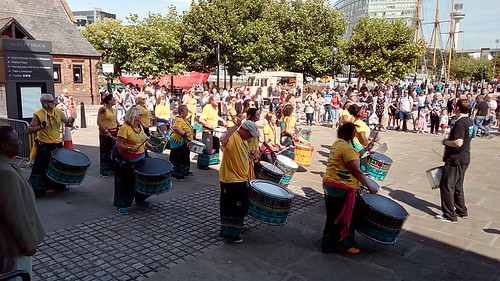International Slavery Museum of Liverpool
On 23rd August 2016 I visited the International Slavery Museum at Liverpool, to celebrate the Slavery Remembrance Day (#SRDLiverpool). The day designated by UNESCO to commemorate the transatlantic slave trade, the date is significant because, during the night of August 22 to August 23, 1791, on the island of Saint Domingue (now known as Haiti), an uprising began which set forth events which were a major factor in the abolition of the transatlantic slave trade[1].
As a student of Greek history it was easy for me to find the link between Liverpool, Haiti and Greece, a story of slavery and revolt.
Slavery in Haiti
Slavery in Haiti has existed since Christopher Columbus arrived on the island in 1492. The practice was so devastating to the native population that the Spanish began importing African slaves[2].
Slavery and Liverpool
Liverpool was a major slaving port and its ships and merchants dominated
the transatlantic slave trade in the second half of the 18th century[3]. Probably three-quarters of all European slaving ships at this period
left from Liverpool. Overall, Liverpool ships transported half of the 3
million Africans carried across the Atlantic by British slavers. That means that a lot of African slaves that lived in Haiti were probably transported from the port of Liverpool.
Haitian Revolution
On the night that spanned August 22 and 23, 1791, slave rebels in the French colony of Saint-Domingue started the Haitian Revolution, the only instance of a successful slave rebellion in world history and the founding event of the first modern black republic[4].
Haiti and Greece
Greeks revolted against the Ottoman Empire on 25th March 1821, and Greece officially declared its independence on 15th January 1822.
Haiti was the first government of an independent state that recognised Greece's liberation from Ottoman rule in 1821[5]. On January 15, 1822 the President of Haiti Jean-Pierre Boyer in his letter to the Greek Committee of Paris announced its recognition of the Greek Interim Administration and wished the victory of the Revolution[6].
There are some sources saying that Haiti offered 25 tons of coffee to fund the Greek state, and also 100 black soldiers from Haiti that died helping the Greek fight for independence, but there are no citations (or at least I still have not found any).
Haiti was the first government of an independent state that recognised Greece's liberation from Ottoman rule in 1821[5]. On January 15, 1822 the President of Haiti Jean-Pierre Boyer in his letter to the Greek Committee of Paris announced its recognition of the Greek Interim Administration and wished the victory of the Revolution[6].
There are some sources saying that Haiti offered 25 tons of coffee to fund the Greek state, and also 100 black soldiers from Haiti that died helping the Greek fight for independence, but there are no citations (or at least I still have not found any).
Liverpool and Greeks
The first large wave of Greeks to the city of Liverpool occurred in 1821 after massacres of Greeks by Turkish invaders on the island of Chios. Significant numbers also came to work for the Ralli brothers, who recruited 40.000 Greeks in cities worldwide including New York City, Geneva and Liverpool. The peak year for emigration from Greece to the USA through Liverpool port was 1907[7].
The Greek community started to form after 1821, and like every community, it needed a centre. The Greek Orthodox Church of St Nicholas in Toxteth was built in 1870 to serve the local Greek community. The Grade II Listed building in Toxteth, Liverpool, is situated at the junction of Berkley Street and Princes Road. It was designed in 1870 by the architects W. & J. Hay and was built by Henry Sumners. It is an enlarged version of St. Theodore's church in Istanbul.
Not sure if it was connected with the presence of Greeks in Liverpool, but when James Radley in 1826 opened his first hotel in Liverpool he named it Adelphi Hotel, from the Greek word "αδελφοί" meaning brothers. Adelphi Hotel became one of the landmarks of Liverpool [8].
The Greek community started to form after 1821, and like every community, it needed a centre. The Greek Orthodox Church of St Nicholas in Toxteth was built in 1870 to serve the local Greek community. The Grade II Listed building in Toxteth, Liverpool, is situated at the junction of Berkley Street and Princes Road. It was designed in 1870 by the architects W. & J. Hay and was built by Henry Sumners. It is an enlarged version of St. Theodore's church in Istanbul.
Not sure if it was connected with the presence of Greeks in Liverpool, but when James Radley in 1826 opened his first hotel in Liverpool he named it Adelphi Hotel, from the Greek word "αδελφοί" meaning brothers. Adelphi Hotel became one of the landmarks of Liverpool [8].
From Merseyside back to Greece
One of the Greeks who lived in Liverpool at that time was Pavlos Carrer. Pavlos Carrer, was a composer from Zante island, an island that was part of the British Empire when he was born (1829) but part of Greece when he died (1896). In June 1842 the young Pavlos Carrer travelled in Europe with his uncle to study in Paris, France, but after visiting Venice, Paris, London they ended up in Woodside near Liverpool [9]. In Woodside Carrer lived in the house of James Spence, where Spence's nephew Maria McNabb (?) taught Carrer music theory and piano[10].
When he left Woodside Carrer continued his musical studies in Corfu and Milan, becoming one of the most famous Greek composers of the 19th century.
When he left Woodside Carrer continued his musical studies in Corfu and Milan, becoming one of the most famous Greek composers of the 19th century.

No comments:
Post a Comment